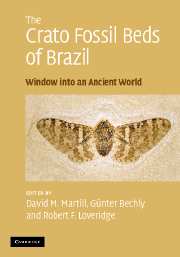Book contents
- Frontmatter
- Contents
- Contributors
- Preface
- Acknowledgements
- Part I The Crato Formation Konservat Lagerstätte
- 1 Introduction to the Crato Formation
- 2 The geology of the Crato Formation
- 3 Stratigraphy of the Crato Formation
- 4 The sedimentology and depositional environment of the Crato Formation
- 5 Commercial exploitation of the Crato Formation
- 6 Preparation techniques for Crato Formation fossils
- Part II The invertebrate fauna
- Part III The vertebrate fauna
- Part IV The flora
- Part V Miscellanea
- Appendix: species list for the Crato Formation
- Systematic index
- Plate section
- References
2 - The geology of the Crato Formation
Published online by Cambridge University Press: 22 August 2009
- Frontmatter
- Contents
- Contributors
- Preface
- Acknowledgements
- Part I The Crato Formation Konservat Lagerstätte
- 1 Introduction to the Crato Formation
- 2 The geology of the Crato Formation
- 3 Stratigraphy of the Crato Formation
- 4 The sedimentology and depositional environment of the Crato Formation
- 5 Commercial exploitation of the Crato Formation
- 6 Preparation techniques for Crato Formation fossils
- Part II The invertebrate fauna
- Part III The vertebrate fauna
- Part IV The flora
- Part V Miscellanea
- Appendix: species list for the Crato Formation
- Systematic index
- Plate section
- References
Summary
Introduction
The Crato Formation crops out around the northern, eastern and south-eastern flanks of the Chapada do Araripe plateau that sits at the boundaries of southern Ceará, western Pernambuco and south-eastern Piauí in north-eastern Brazilian caatinga (Martill, 1993; Neumann and Cabrera, 1999).
The formation comprises a heterolithic sequence of clastic and carbonate strata currently restricted to within the Araripe Basin and a few smaller, interconnected basins such as the Serra do Vermelha and Cedro Basins (Assine, 1990, 1992; Carvalho, 2001). It is remarkable for its exceptionally well-preserved fossil assemblages and its limestones are economically important for cement manufacture and building materials (see Chapter 5). Parts of the formation, especially some of the limestone units, are also remarkable for their lateral continuity considering how thin some of the units are and how lithologically variable the sequence is vertically. There have been few detailed studies of the geology, stratigraphy or sedimentology of the Crato Formation as a stratigraphic unit, but the palaeontology of the lowermost of its limestone members has received considerable attention. The unit was first mapped in detail during the Projeto Santana as a separate entity (Moraes et al., 1976), although its definition was unclear. Beurlen (1962, 1963) provided a series of cross-sections across the Chapada do Araripe demonstrating its unconformable relationship with the basement and overlap by younger strata.
- Type
- Chapter
- Information
- The Crato Fossil Beds of BrazilWindow into an Ancient World, pp. 8 - 24Publisher: Cambridge University PressPrint publication year: 2007
References
- 10
- Cited by

